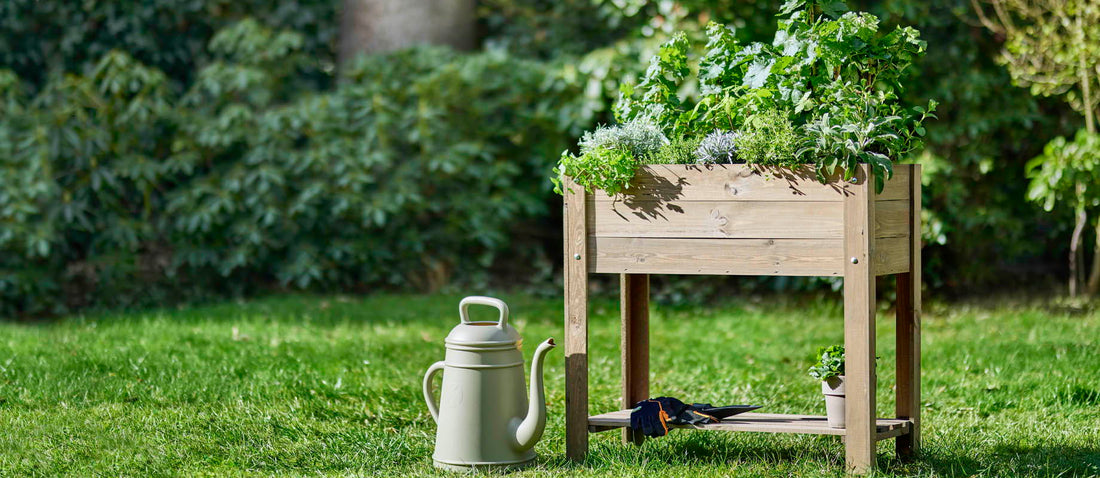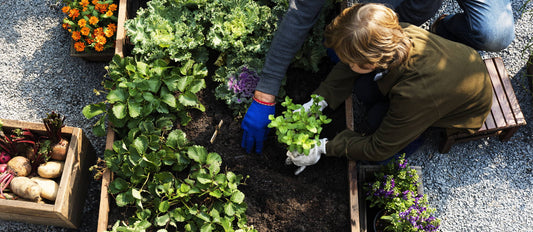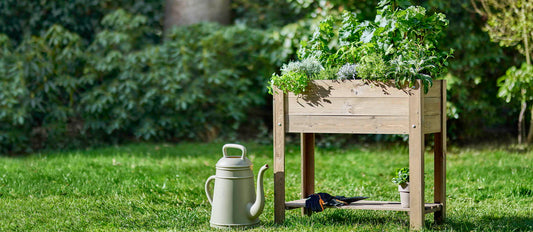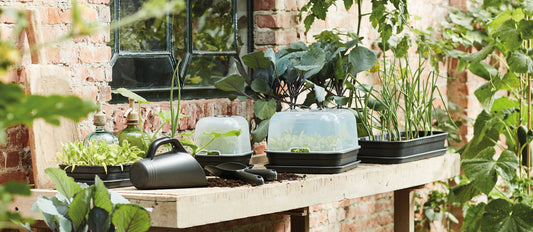What could be better than enjoying your own home-grown vegetables and fruit! The good news is that it's easier than you think. Thinking about a vegetable garden often brings a glass cabinet in the garden to mind, but it's not essential! You can have a vegetable garden in many more places than you might think: in a vegetable planter on the patio, in a pot on your balcony or even indoors. The sky's the limit!
We've put together a step-by-step guide to growing vegetables for all newcomers to vegetable gardening. Follow this plan and you'll have your own vegetable garden in no time (OK, you might need a little bit of patience).
The ideal time to start your (first) vegetable garden is in the spring. The sun is starting to shine again and your vegetables, fruit and herbs just love that. Planting in the spring will yield a harvest as early as the summer.
Step 1. Pick the place for your vegetable garden
First, choose the location of the vegetable garden before you start buying things. It's easier to make choices once you know where you're going to plant it. Would you prefer to start small? Then why not start with a herb plant in your home, for example. Are you keen to dive right in? First consider whether you want to transform part of your garden into a veritable paradise of fruit and vegetables or whether you want to start smaller, for example with a grow box on your balcony. Deciding first on the location and size of your vegetable garden makes it much easier to choose what you want to grow.
It's important to bear in mind that lots of fruit and veg like the sun. A south-facing vegetable garden will always do best. But this doesn't mean that it's impossible to have a successful vegetable garden in other settings. Not lucky enough to have a sunny balcony or garden? There are also vegetables that grow excellently in partial shade, such as carrots, beetroot, lettuce and spinach.
Step 2. Choose what you are going to grow
Now you know how you're going to set out your vegetable garden, you can choose which vegetables, fruit and herbs you're going to grow. Of course, you'll want to pick your favourites but there are a few points you need to take into account:
- The amount of space that the plants occupy
- Whether the plant is suitable for open ground or should only be grown in pots or planters
- The sowing season (download here our sowing calendar)
- The harvesting season
Don't make it too difficult for yourself: start with easy-to-grow vegetables.
Are you still a novice in terms of vegetable gardening? Then start with something easy. Lettuce, radish, carrots, spinach and potatoes are easy to grow. There's not much to go wrong. Not even for the greenest vegetables.
Step 3. Get all the supplies you need
Once you have finished planning your vegetable garden, it's time to starting getting all the necessary supplies. What do you need?
- If you're starting with seeds then you'll need nursery pots (see step 4).
- A grow box where you can start with a small vegetable garden.
- Potting soil is very important for the health of your plants and the success of your vegetable garden. We recommend special potting soil for vegetable gardens. It contains up to 100 days of plant food and stimulates the growth of your plants.
- Of course, the seeds are the most important thing on your list. Choose your favourite fruit, vegetable and herb seeds.
- A grow tunnel is important for any plants in your vegetable garden that are not able to withstand wind or cold weather. If you want to keep your vegetable garden outside all year round, this item is a must.
- It is also useful to have a "climbing frame" for climbing fruit and vegetable plants such as blackberries, raspberries and grapes.
- A special insect control mesh to reduce the impact of pests on your vegetable garden.
Step 4. Sowing indoors
Some fruit and vegetables, such as tomatoes and peppers, need to spend a little time growing indoors before they can be planted outside. The best time to sow indoors is in February and March. You'll need nursery pots for this. Always make a hole at the bottom of the pots for good water drainage. Place them in a bright, warm spot. This will help the seeds to germinate. After a while they can be replanted in the vegetable planter or vegetable garden. Read more about sowing indoors here.
Be green
Our nature pots are biodegradable. That means you do not have to transplant the vegetables – the roots can grow freely through the pot. Easy when you eventually move the vegetables outside.
Step 5. Get the vegetable garden underway
Get started with your vegetable garden! Fortunately, most of the information you need about how to grow the seeds can be found on the seed packaging. Make sure to read carefully all the information regarding how much space there should be between the plants and divide up the grow box, pot or part of your garden accordingly. Before sowing, make sure that the soil is loose and has been thoroughly watered. Then make some small holes with your finger (pay attention to the distance between these holes) and place one of the plants that you previously sowed indoors in each hole. If you haven't already sowed them indoors, just put a few seeds in each hole. Then it is simply a matter of waiting for everything to grow. Be patient! It is only a matter of time before you will able to enjoy the harvest from your vegetable garden.
Extra vegetable gardening tips
- Don't sow too deep. It's just not necessary. Keep to the following rule: sow approximately as deep as the size of the seed. For a plant that you previously sowed indoors, dig a hole that's a bit deeper than the height of the pot the plant was originally in.
- Don't forget to label each plant! This means you won't forget what you are growing. This might seem like stating the obvious, but it's an easy step to miss out.
- If multiple plants grow out of one of the holes you made, remove the smallest. This makes sure that the plants don't get in each other's way.
- Don't plant too many of the same crop; choose a whole range of different types of fruit and vegetables. For example, create several planting areas in your vegetable planter or flower pot. This way you'll never have an excess that you have to give away or store.
- If you want to plant the same crop in several areas, plant them at different times. For example, you can start planting a number of lettuce crops every two weeks so that you can enjoy fresh salads for longer.
- Since vegetable gardens are often plucked clean when the crop is harvested, always plant seeds from a different plant family to replace them. By changing the crop each time you plant, you can prevent diseases, pests and weeds.
Step 6. Maintain the vegetable garden
While you're waiting for your plants to be ready to harvest, it's important to maintain your vegetable garden properly.
The special potting soil for vegetable gardens that you used has plant food for up to 100 days. Once this time has elapsed, which will be stated on the packaging, it's important to add some extra vegetable garden food. Of course, it's organic.
You can offer extra protection against insects by covering the vegetable garden with a fleece. A layer of mulch can also have a protective effect. Mulch improves the quality of the soil, stops weeds and retains heat and moisture. A good mulch layer consists of old leaves, plant waste and soil.
It is important to keep checking the vegetable garden for weeds and to remove them carefully. The roots of your vegetable garden plants can become entangled in the weeds. Check for weeds every day. In general, it is easy to prevent weeds with proper care and by planting different plant families in the vegetable planter.
Step 7. Time to harvest!
Every type of fruit and vegetable has its own planting and harvesting period. It also takes different amounts of time for the seeds to grow, plus of course the weather plays an important role. Warmer weather will make the crops grow faster and mean that they are ready to harvest sooner.
Conveniently, for a lot of vegetable types it's obvious when they are ready to be harvested. For example, you can harvest beetroot and radishes as soon as their heads start to peep out of the ground. For other vegetables, you have to look at what colour and how strong their leaves are. If the leaf looks sturdy, fresh and green, it's usually time to harvest. You don't want to let vegetables that grow above ground grow too big, as they can lose their taste. Harvest them as soon as you see that the vegetables are big enough and are a good colour.




